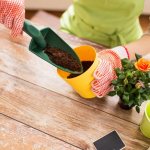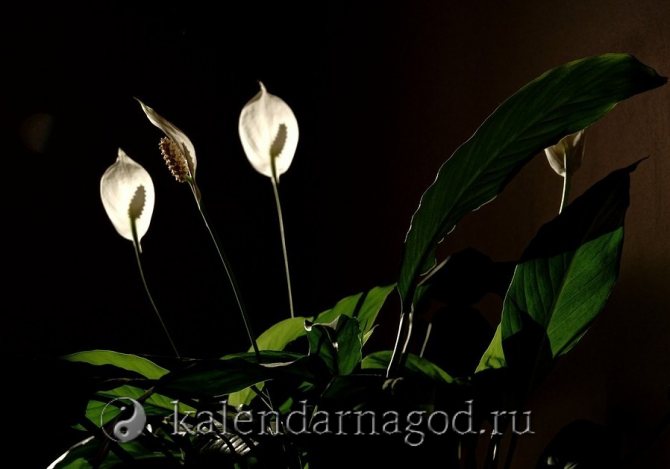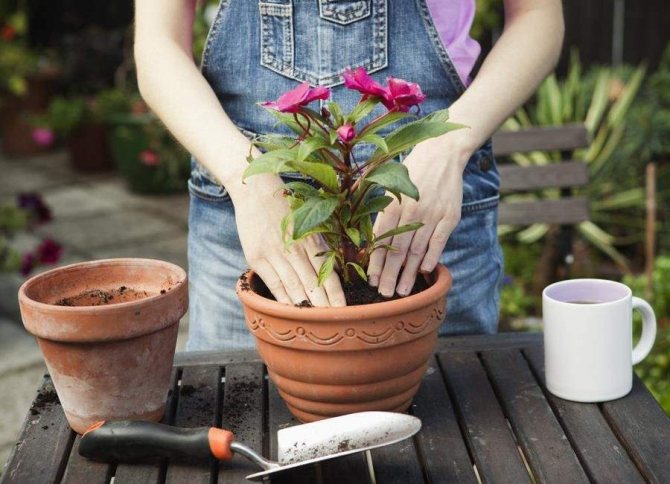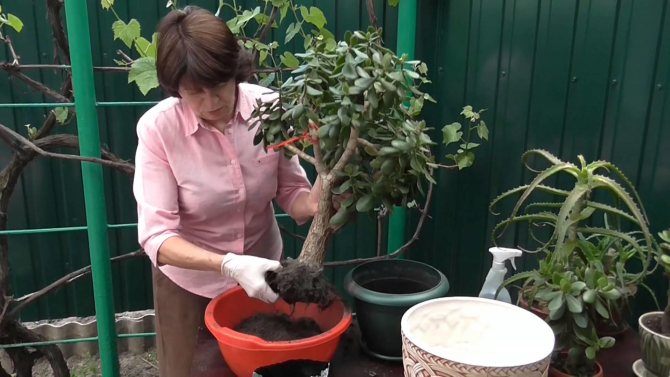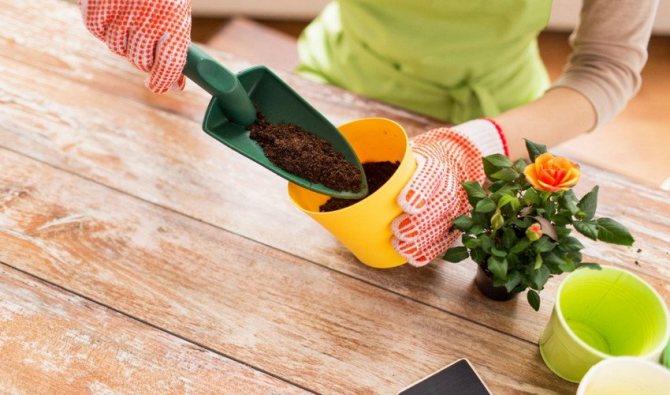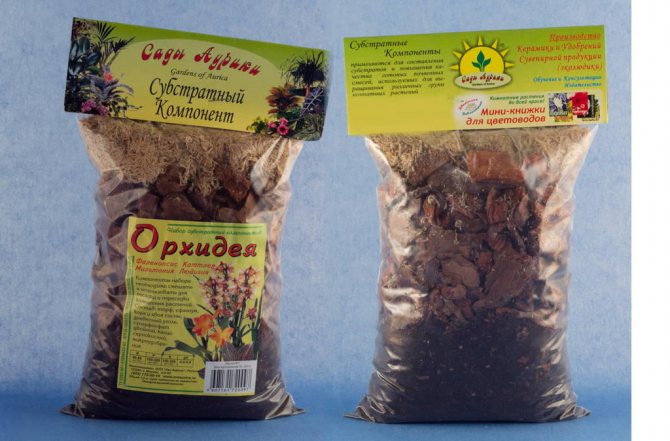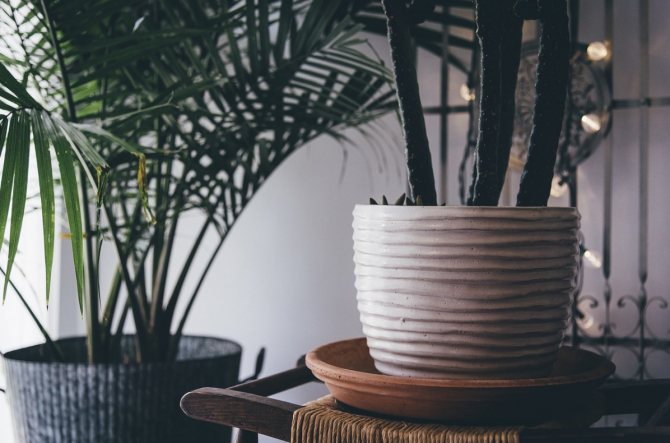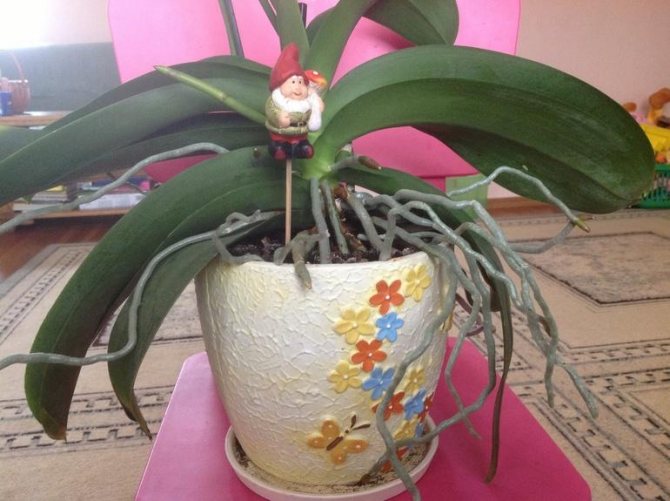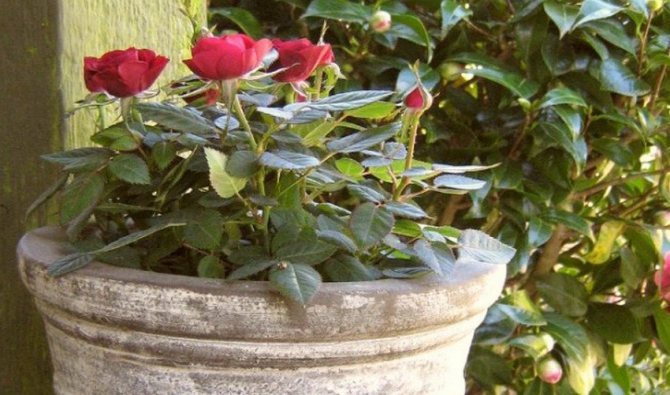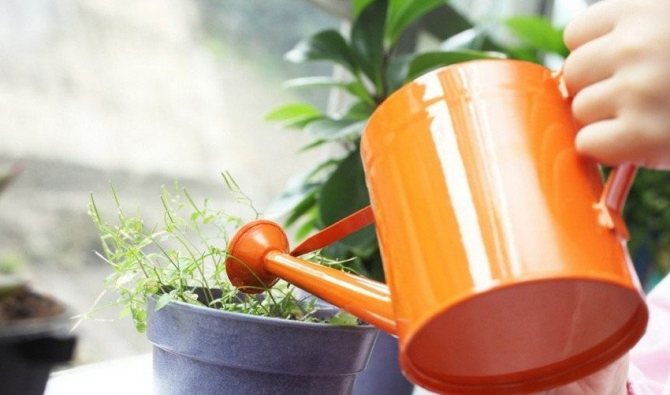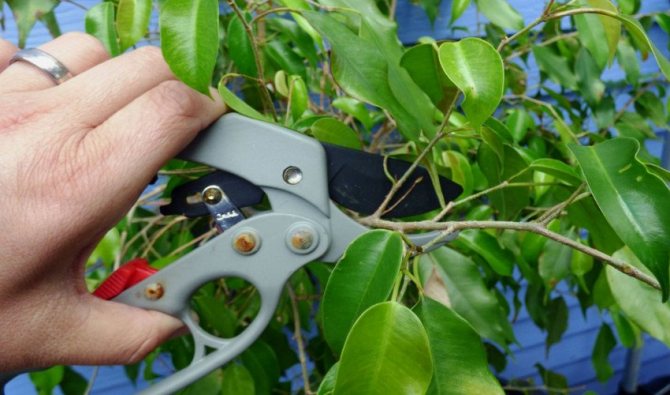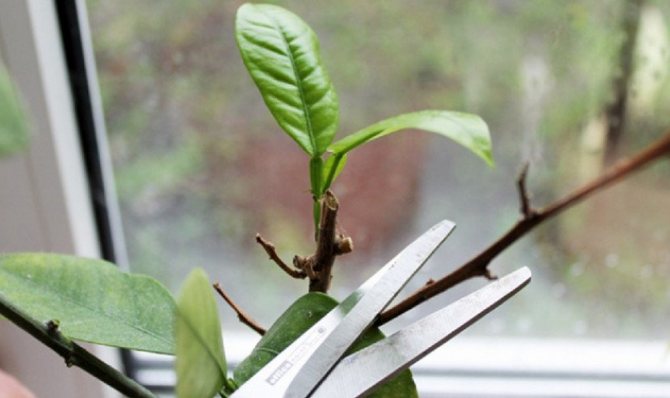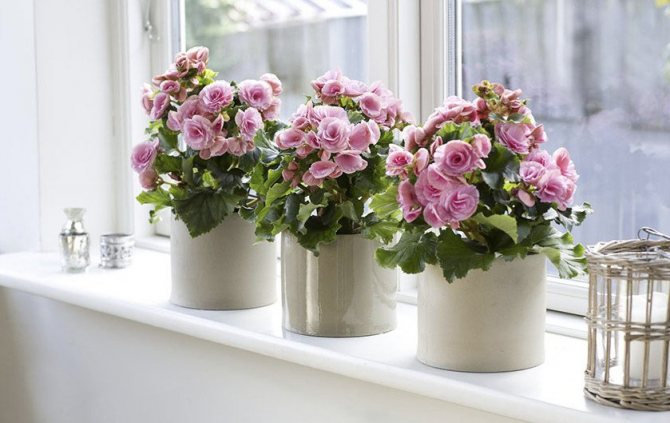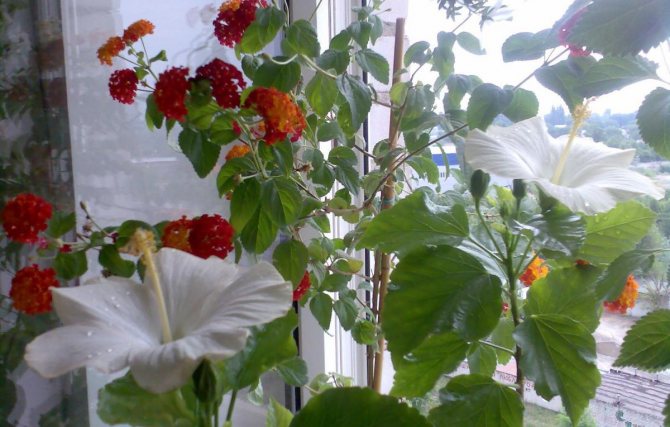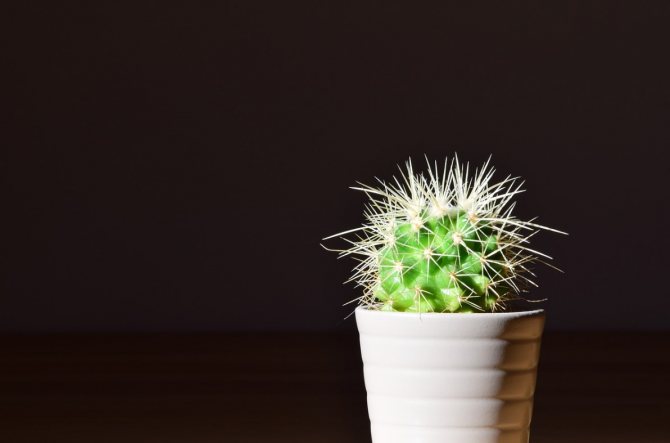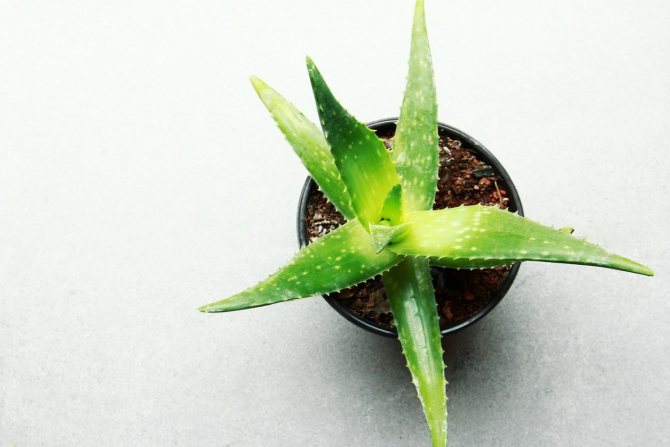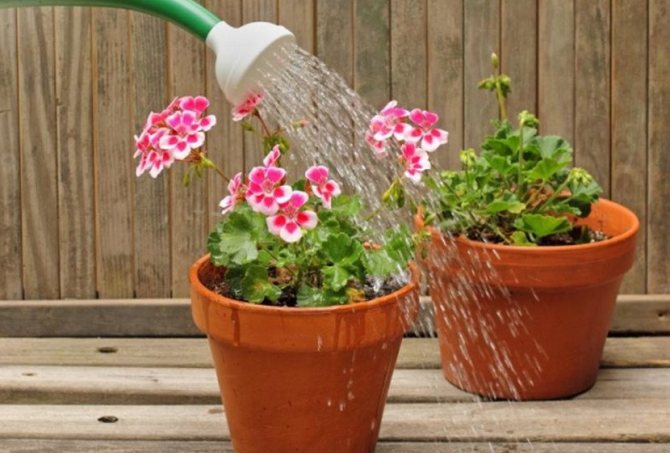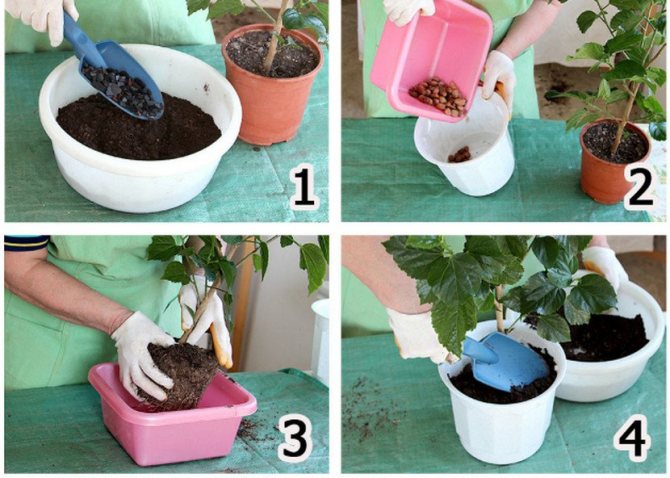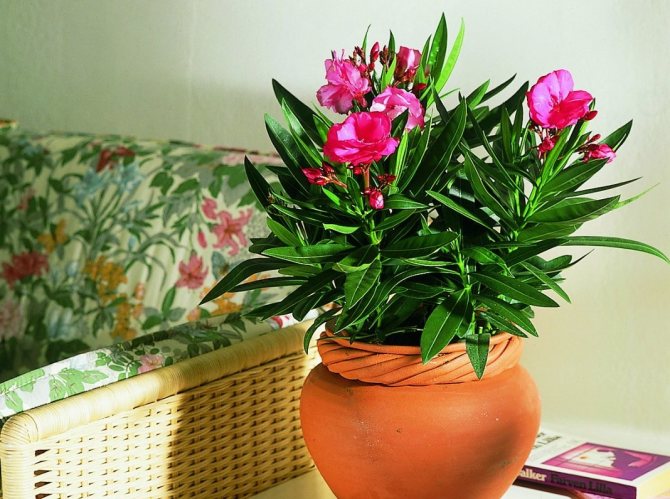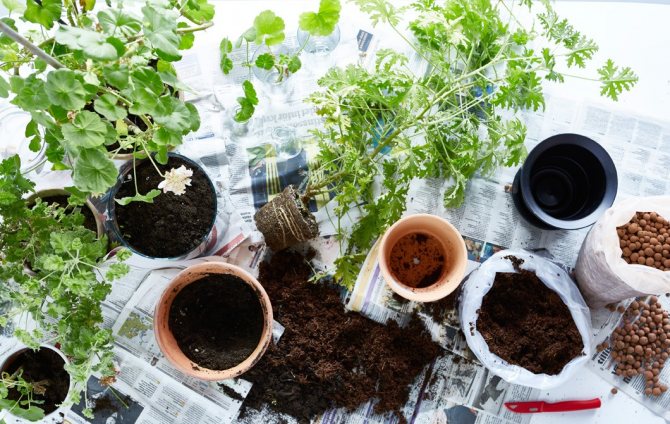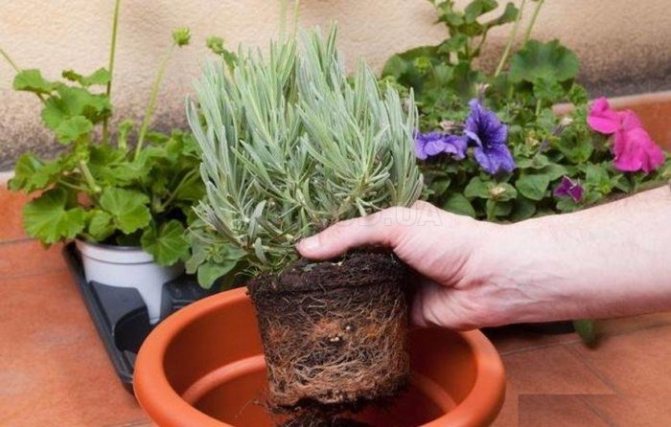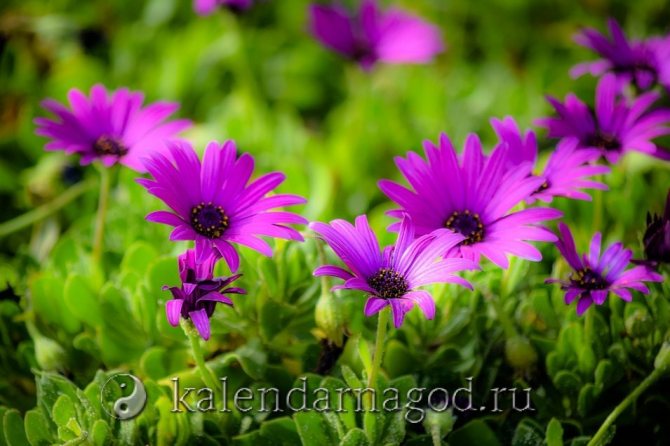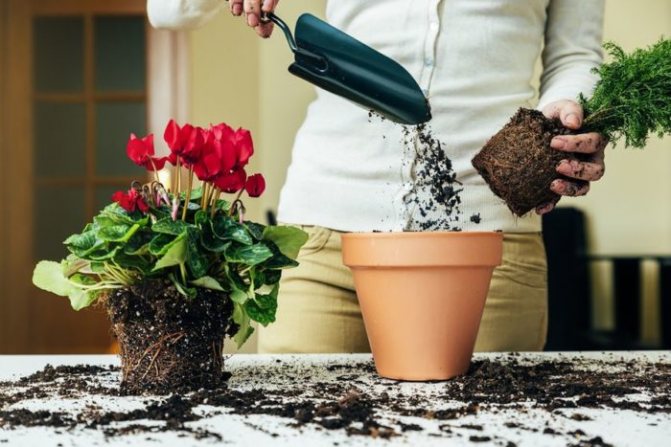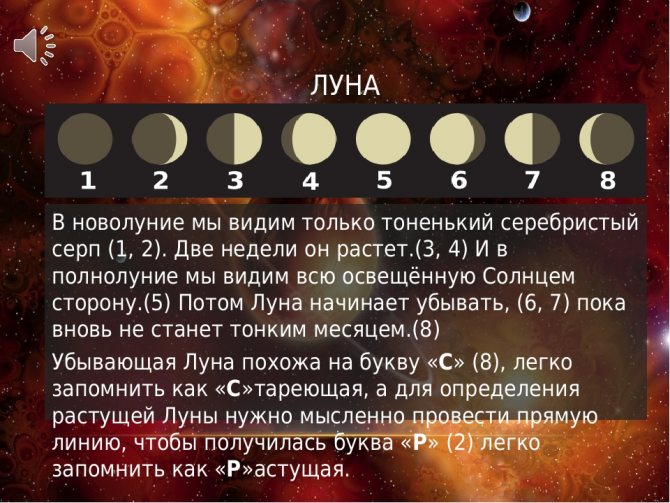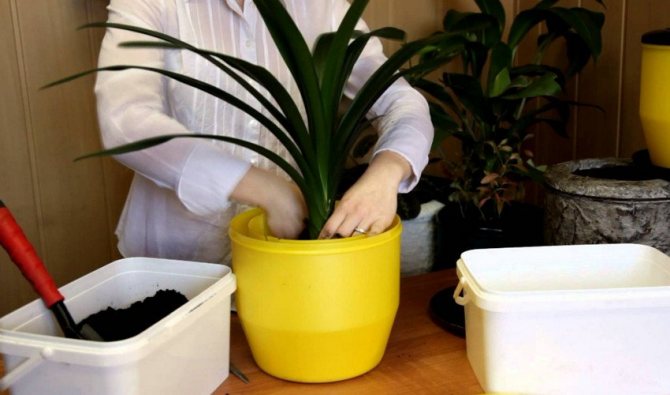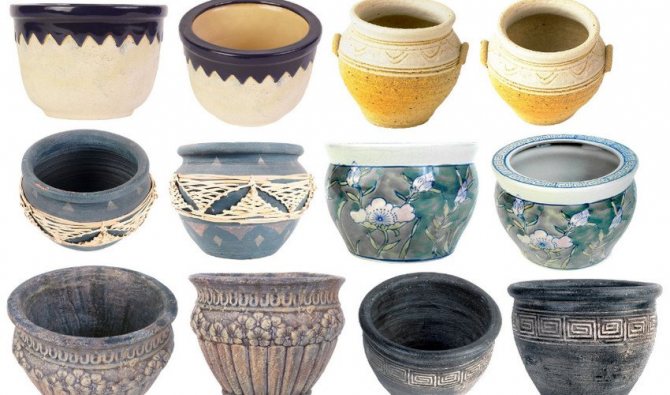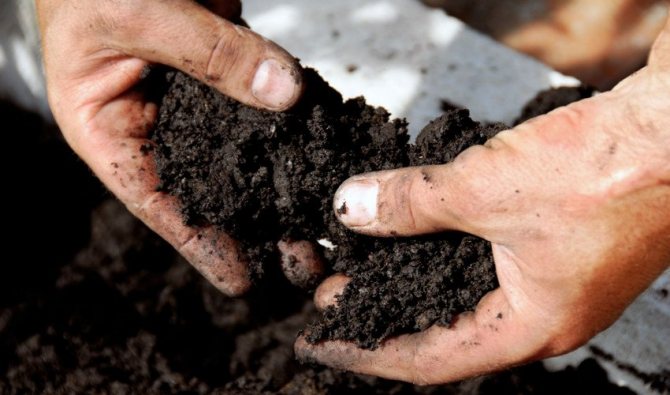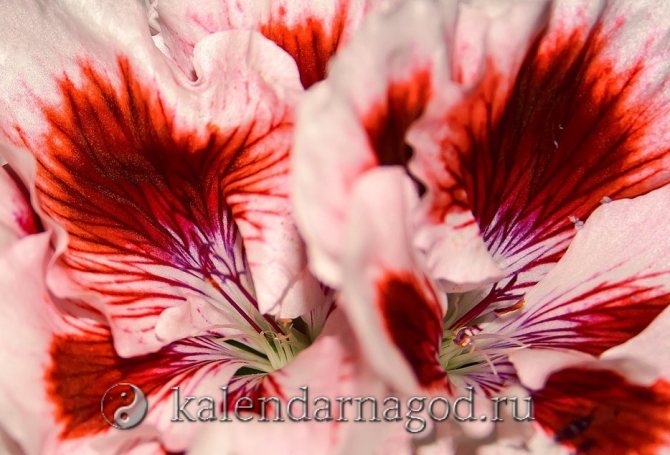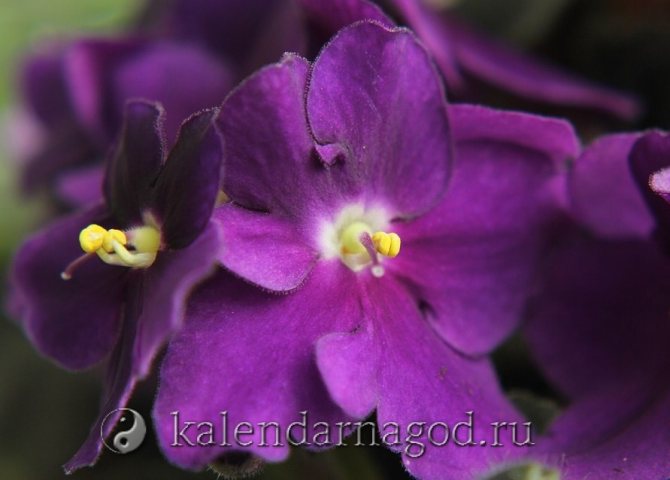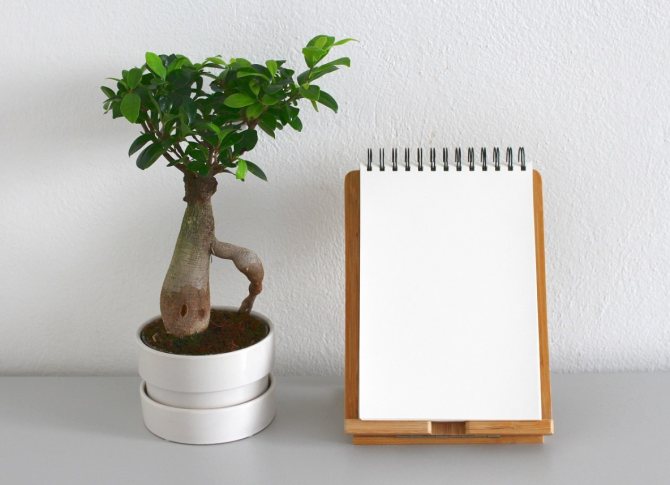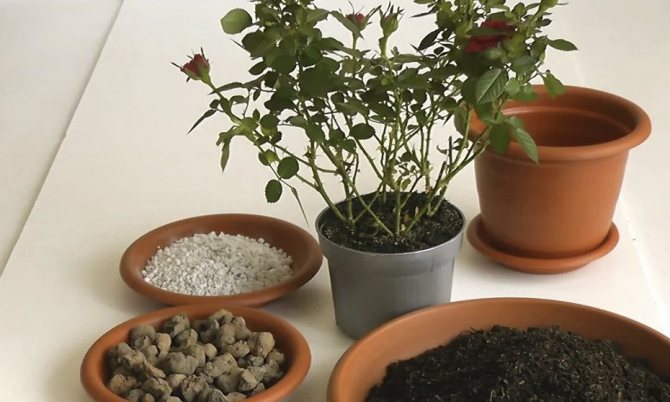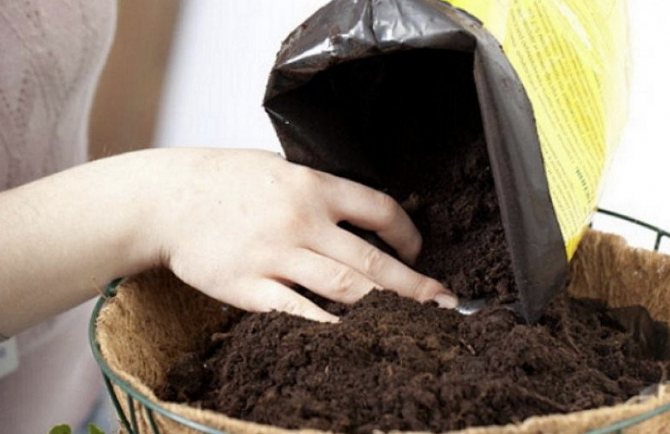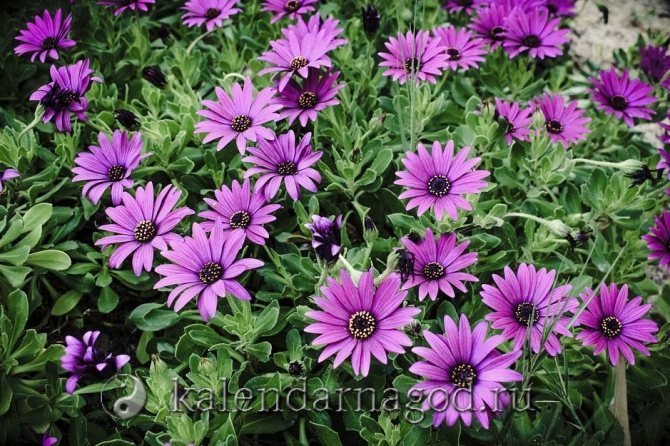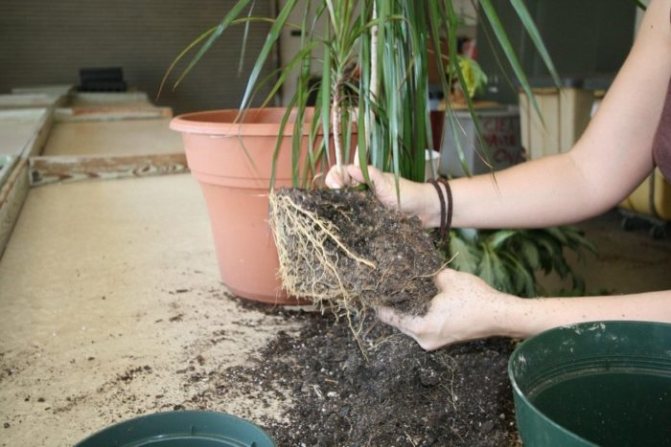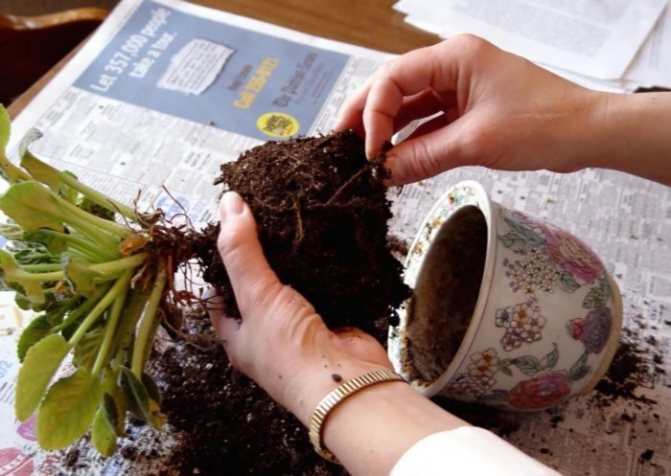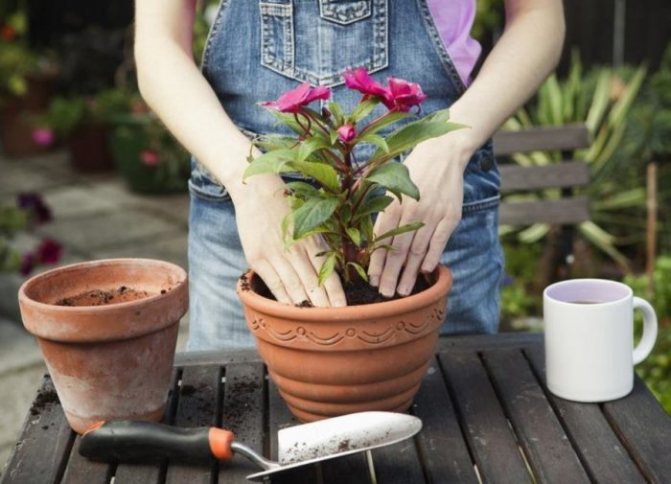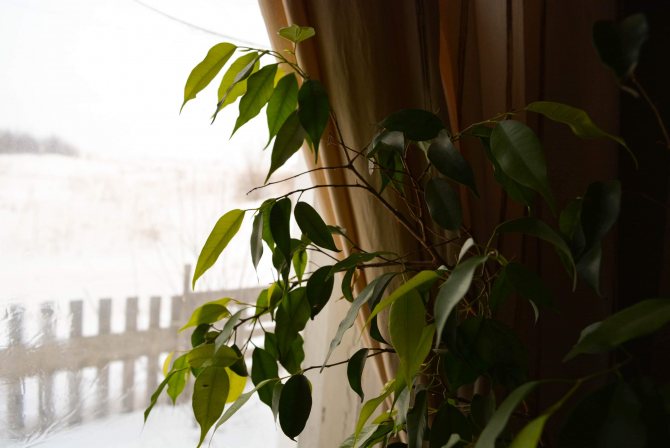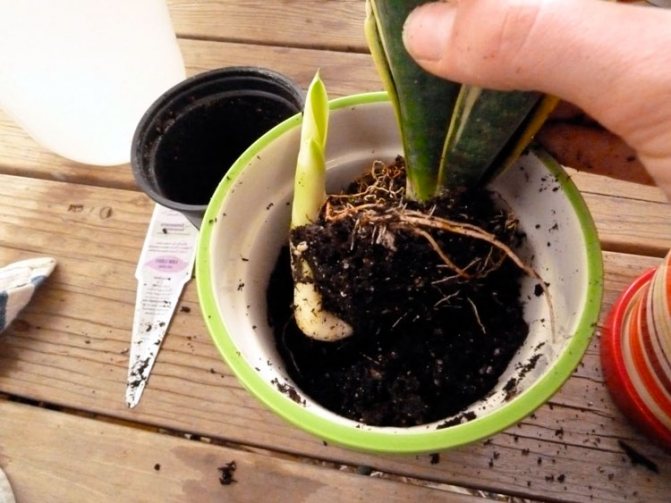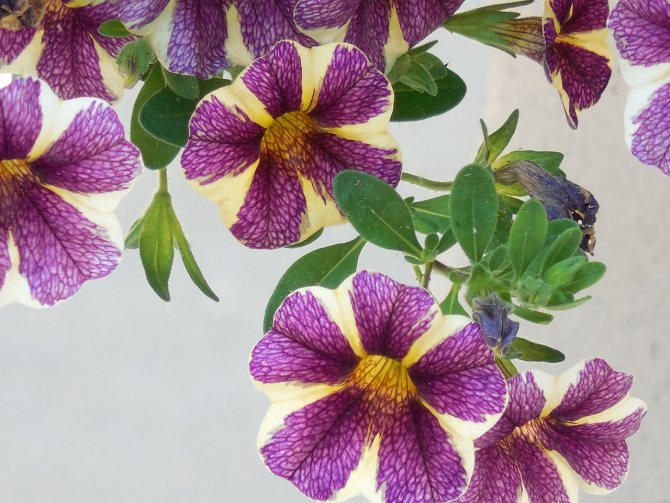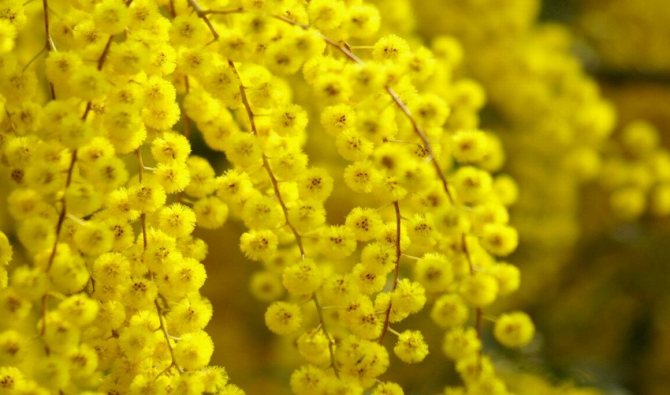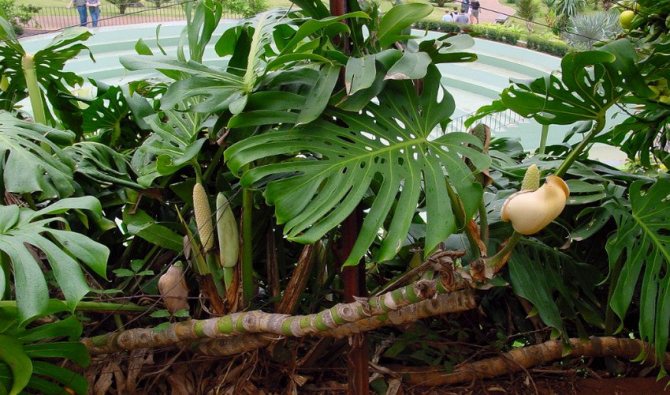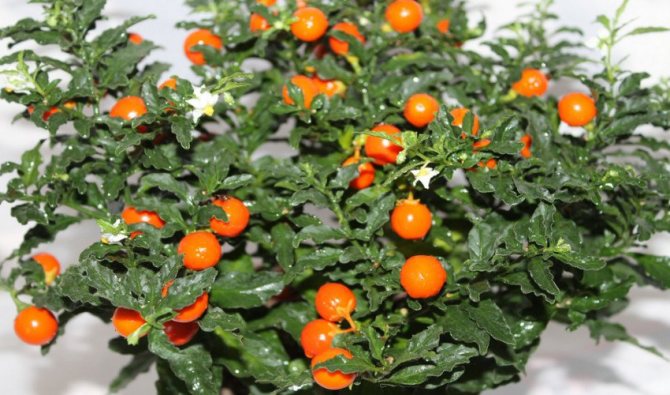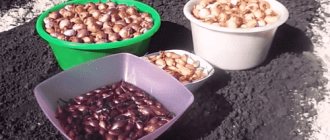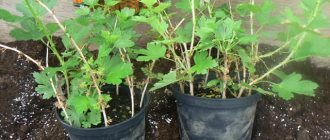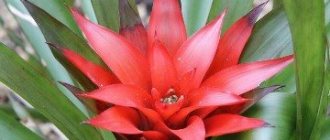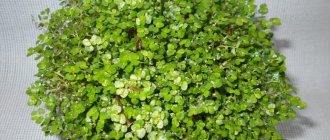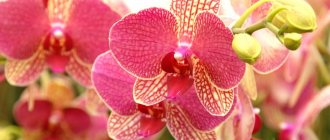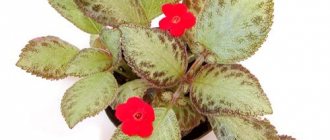Indoor plants are divided into 4 large groups and numerous species, each of which requires certain conditions of maintenance and care (temperature, humidity and lighting, watering regime, soil and pot size, frequency of fertilization, and so on).
But, despite such a variety of plants, it is quite possible to single out the basic rules for the care and maintenance of home flowers, relating to all or at least most species and groups. This applies to the choice of soil, pots, drainage and the very process of planting / transplanting / handling flowers. We will consider how to plant a home flower correctly in this article.
Why it is important to know a favorable day for a transplant
Experienced growers know that the result of plant transplantation largely depends on the correct choice of the time of year and the day of the procedure. For the correct selection of the transplant date, there is a special lunar calendar of the florist.
With the help of such a lunar calendar for transplanting indoor plants, you can easily choose the most successful day for various procedures for caring for indoor plants, whether it be watering, fertilizing, pruning or transplanting a plant.
During transplantation, flowers are especially stressed, they can recover for a long time, get sick and even die due to improper care, soil selection, and also often an inappropriate transplant date.
Those periods of the lunar cycle are suitable for transplanting, during which the sap of the plant moves from the roots to the leaves. As a result, the leaves break less and the roots are not injured. The plant is less sick and takes root in a new place faster.
Florist's calendar for October 2019 for works in a flower garden
The lunar calendar can give more detailed recommendations for October 2019 regarding gardening. Days suitable for planting and transplanting may not be suitable for nursing, and vice versa.
Flower transplant in October according to the lunar calendar
Perennials that stay in one place for several years in a row manage to deplete the soil. Therefore, they are advised to regularly replant, this should be done outside the flowering period, in spring or autumn. Autumn planting is practiced more often - perennials quickly take root in a new place and, with the onset of spring, start up active growth.
Transplanting perennials in the garden in October 2019 is best:
- in the waxing moon phase - from 1 to 13, while it must be remembered that 7, 8, 9 are poorly suited for transplantation;
- in the waning phase - after the 15th and until the end of the month, with the exception of 12-15, as well as 27-29.
Important! Flower growers cannot transplant tubers to a new location on October 14th. On this day, the lunar calendar shows the full moon, and, therefore, it is better to give the plant roots and stems complete rest.
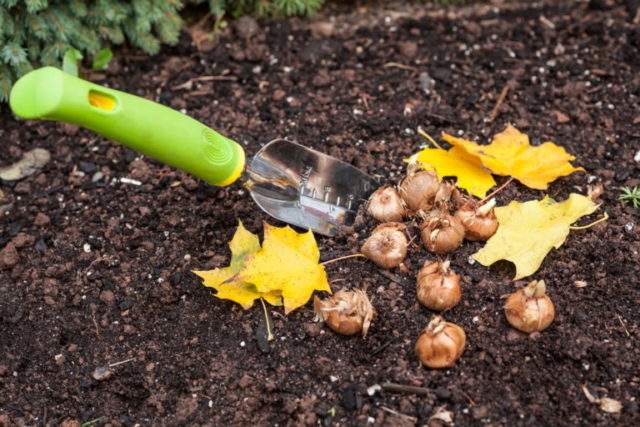
In the second month of autumn, very many days are suitable for planting.
Planting flowers in October according to the lunar calendar
In general, the timing of planting new perennials in the garden coincides with the timing of replanting plants. In both cases, in the fall of 2019, the flowers should take root in the soil as quickly as possible in order to survive the winter well.
However, the lunar calendar gives separate recommendations for flowers growing from seeds and bulbs:
- It is best to plant bulbous perennials in the first half of the month.The first 4 days are considered optimal, as well as the period from 10 to 17, with the exception of the full moon.
- The seeds can be sown in the soil throughout the month. In 2019, it is better to do this before the new moon - on the 3rd, 4th, 10th and 11th, and during the waning moon - from the 17th to the end of the month, excluding the days of the new moon.
The lunar calendar advises taking into account the phases of the night star, but focusing primarily on the weather. Seeds and bulbs are never planted in frozen soil, if the fall is planned to be cold, planting work is best done early.
Florist's calendar for October for the care of garden flowers
Planting and replanting are not the only jobs for the florist in October 2019. Perennials in the garden must be prepared for the cold - to clean up the flower beds and create all the conditions for full wintering.
The lunar calendar 2019 advises to distribute work in this way:
- Most perennials require pruning before winter. It is better to spend it on the waning moon at the end of the month, when the life juices rush to the roots. The 17th, 19th, 21st and 23rd are considered good days, but you should not touch the flower beds on the new moon.
- In October 2019, the flower beds in the garden need to be properly watered in order to create a moisture reserve in the soil, this will protect the roots from freezing. Watering is best done on 10-12 and 15-17, also the lunar calendar allows you to water the flowerbed on the 30th, but this must be done for cold-resistant plants. Simultaneously with watering, it is recommended to apply top dressing, the florist needs to add complex minerals without nitrogen content to the soil.
- The most important stage in preparing for winter is shelter for the winter. It is necessary to carry it out for flowers, depending on winter hardiness. Species sensitive to frost are covered by flower growers according to the lunar calendar 2019 at the beginning of the month - from the 2nd to the 9th. For winter-hardy varieties and species, covering work can be transferred to the waning moon at the end of the month - from 19 to 3.
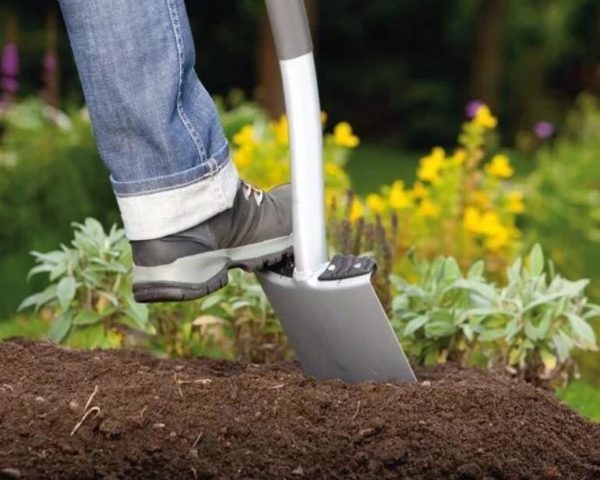

It is also necessary to loosen, water and fertilize the flower beds according to the astronomical schedule.
Advice! 17 and 19, as well as 23-15, you can loosen the soil. These procedures will provide good air permeability to the soil and improve moisture saturation during irrigation.
What perennials can be propagated in October
Not all perennial plants are suitable for autumn planting and transplanting. The following varieties respond best to reproduction in the fall:
- badan, lungwort and brunner;
- aquilegia and astilba;
- primroses and herbaceous peonies;
- roses, chrysanthemums and asters;
- irises, delphinium and lilies;
- daylilies and phloxes.
In the fall of 2019, flower growers can plant daffodils, tulips and hyacinths. However, they need to be propagated if the temperature has not dropped too low yet. The optimal time for the reproduction of flowering perennials is September and the beginning of October, therefore, the florist needs to carry out work as early as possible.
How to transplant a plant correctly
If an urgent indoor plant transplant is not required due to pests or other circumstances, then it is best to check with the lunar plant transplant calendar.
The optimal period is the growth of the moon. During this segment of the lunar cycle, the plant juices go from the roots to the top, so the roots feel less stress from the transplant, grow faster, and the leaves break less.
Do not repot the plant during flowering. From such a transplant, an indoor flower is severely injured, it takes a long time and is difficult to recover, even if the manipulations were carried out on favorable lunar days.
How the moon affects houseplants
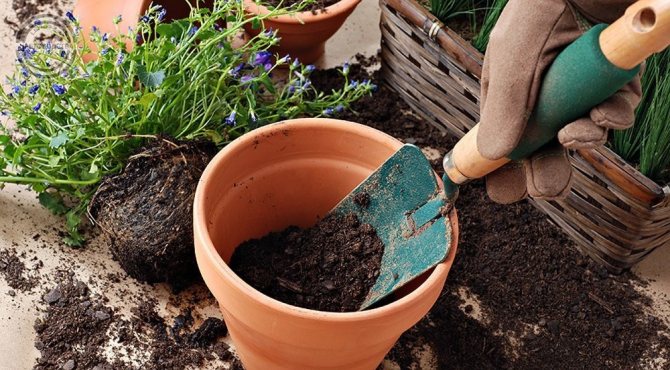

The new moon is the worst phase for all vegetation, at this time no procedures with flowers, shrubs, herbs and trees can be carried out. With a full moon, the greens gain maximum juice, the satellite transfers all its strength to the plants.Transplanting and cutting during this period are contraindicated, in the case when the houseplant bears fruit (citrus fruits, homemade pomegranate, hot peppers, strawberries, etc.), you can harvest.
On a note! On a new and full moon, if absolutely necessary, it is permissible to process flowers from diseases and harmful insects.
The growing moon provokes and accelerates the movement of juices from the roots to the green mass. Minor mechanical damage to the rhizome heals faster, this is the optimal time for planting. With the waning moon, the juices are directed from tops to the roots, which become vulnerable. Preventive measures should be taken - feeding and pruning. In the decreasing phase, the transplantation of corms is allowed.
Optimal timing for flower care
The period of the waxing moon is considered optimal for caring for a home garden. It is recommended to replant indoor plants during certain months. In the spring, it is March and May, in the winter it is December, in the summer it is July and August. All three autumn months are great for transplanting home flowers. During these months, the root system of plants is the least susceptible to various injuries and adapts most quickly to the new soil.
Moon calendar
The lunar calendar takes into account not only the phases of the moon, but also the constellations in which the satellite of the Earth is located at a given time period.
Some signs of the zodiac have a beneficial effect on plants, and some depress.
When the Moon goes along constellations favorable to fertility, then there is an increase in all energy processes of plants. Flowers planted at the right time have a powerful root system, they adapt quickly, and get sick less. The fertile signs of the zodiac include:
- calf
- Virgo
- Cancer
- Scorpio
- Libra
All other constellations are considered unfavorable for flora and it is not recommended by astrologers to transplant flowers during those periods when the Moon is in them.
Can indoor flowers be transplanted in October?
Sometimes passing by someone else's pot with a cherished flower, the hands themselves reach out to pinch off a small process. But what if October 2019 is not the best time to reproduce and transplant plants outside the window?
Again, it is worth referring to the characteristics of your favorite flower. For example, geranium easily propagates by semi-lignified, green cuttings in August - early October…. Dichorizandra, ostyanka (oplismenus), netcreasia, syngonium legoliate or tradescantia will take root no less quickly in October. By the way, the list of plants is far from being exhaustive. Maybe the list will be replenished with a new species?
The problem of transplanting (handling) your favorite flowers during this period is no less relevant. What if the optimal time for replacing the soil is missed, and the plant has grown to an immense size? Of course, in some cases, it is advisable to postpone the event until early spring. However, for some indoor plants, October 2019 is quite suitable for transplanting.
For example, in the middle of autumn, you can safely refresh the soil for almost all varieties of azaleas; callam (calla lily); amaryllis; achimenes; spathiphyllum; petunia; dracaena; tradescantia; chlorophytum; asparagus and many other plants that were planted in the garden for the summer.
Important! Only healthy flowers are allowed to transplant (reload) in October, which will have enough strength to recover from stress on the last sunny days.
Moon phases
Different phases of the moon have different effects on the state of plants after transplantation. The new moon is a difficult period for all living things: energies are renewed, organisms get rid of all that is superfluous, therefore, manipulations with plants during this period should only be done in extreme cases.
With the growing moon, plant juices rise up from the root system to the leaves, so root damage is easier to tolerate.In addition, with the growth of the moon, all the energies of the plant increase, it copes with stress more easily and quickly grows. It is also customary to plant flowering plants on the growing moon, it is believed that they will bloom more abundantly.
On the Full Moon, plants are saturated with juices and energy, therefore Astrologers do not recommend pruning and transplanting. But in the period of the full moon, the collection of flowers and fruits is favorable.
During the waning moon, plant juices and vital energies move from top to bottom, to the root system. The activity of the plant decreases, it rests. During the period of the decline of the Moon, preventive work is carried out related to the stem and leaves: plant grafting, pruning. On the waning moon, all these procedures are most painless for the flower.
Favorable and unfavorable days for plant transplanting and caring for them
Successful and unsuccessful days for transplanting indoor plants are determined based on the current phase of the moon and the sign of the zodiac in which it is currently located.
| Month | Favorable days of planting and transplanting plants | Unfavorable days for planting and transplanting plants | Forbidden days for any manipulation of plants |
| January | 1-3, 10-11, 15-20, 24, 28-29 | 5, 7-9, 22 | 6, 21 |
| February | 1, 6-8, 12-17, 21, 25, 27-28 | 3-4, 11, 18, 20 | 5, 19 |
| March | 7, 10-12, 14-16, 19-20, 23, 27-29 | 3-5, 13, 17-18, 22, 30-31 | 6, 21 |
| April | 2-3, 7-11, 16-20, 24-26, 29-30 | 1, 4, 12-15, 21, 27-28 | 5 |
| May | 1, 6-10, 13-18, 21-23, 27-28, 31 | 4, 11-12, 20, 24-25 | 5, 19 |
| June | 4-6, 9-10, 12-18, 24, 28-29 | 2, 7-8, 11, 19, 20-22 | 3 |
| July | 3, 6-9, 11-14, 21, 25-26, 30 | 4-5, 10, 16, 18-19, 31 | 2, 17 |
| August | 3-8, 10-12, 16, 18, 21-22, 27, 31 | 2, 14, 17, 28-29 | 1, 15, 30 |
| September | 1-6, 8-9, 13-14, 18-19, 22-24, 29-30 | 7, 10-12, 15, 25-26 | 28 |
| October | 1-5, 10-11, 15-17, 21, 29-31 | 6-9, 22-23, 27 | 28 |
| November | 1-3, 6-8, 11-12, 27-30 13, 17, 20 | 4-5, 18-19, 25 | 26 |
| December | 3-5, 8-13, 17, 19, 23, 27, 31 | 1-2, 15-16, 25, 28-30 | 26 |
The most unfavorable days for manipulating indoor flowers are the days of the new moon and eclipses. Solar eclipses in 2019 are coming January 6, July 2, and December 26. Lunar eclipses will take place on January 21 and on the night of July 16-17, 2019.
It is equally important which zodiac constellations the Moon is in at the time of the proposed plant transplant.
The signs of Pisces, Cancer, Scorpio and Taurus are considered auspicious.
Plants planted during these periods grow well with strong roots and stocky stems. The signs of Libra and Capricorn are moderately fertile. Plants planted under the Moon in these constellations bloom well and have a pleasant aroma. Virgo, Gemini and Sagittarius are weakly fertile signs. You should not plant indoor flowers during the periods when the moon is in these signs of the zodiac. Climbing plants are an exception.
The signs of Aries and Leo are called barren. During the periods when the Moon is in these signs, drought-resistant plants are planted, or with bright red flowers.
The most unfavorable Astrologers consider the sign of Aquarius. With the Moon in this sign, it is better to refrain from transplanting plants, with the exception of experimental crops.
Choosing a pot / planter
In flower shops today there is a huge variety of pots and planters. What is the difference between a pot and a pots? The flowerpot has one or more drainage holes on the bottom, which are designed to drain excess water when watering the plant.
The planter does not have holes at the bottom and is used not for planting flowers, but for decorating the interior. It can be completely carved, woven from a vine, carved from stone, made from wood, metal, plastic, glass, etc.
Also, a pots of a certain shape can be hung on the wall, and if there are special holes / hooks / ears, they can be hung with a cord from the ceiling (window, terrace beam, etc.) and a pot with a flowering ampelous plant can be placed in it.
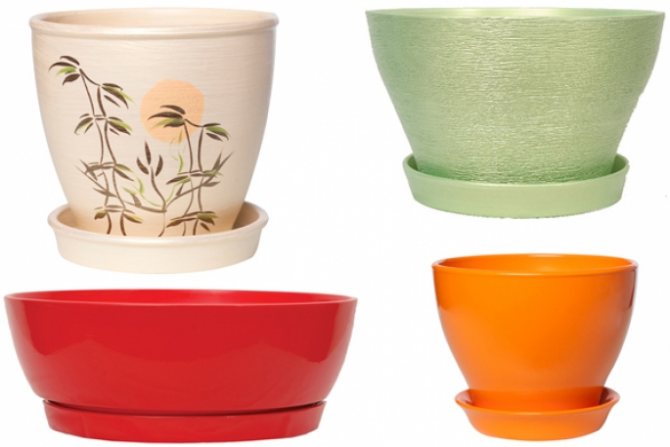

The assortment of flower pots is no less wide and numerous. It includes products from:
- Clays. The finished product can be fired, painted, glazed or without any decoration on the outer surface. Clay pots are usually made in standard shapes and proportions, with a height to diameter ratio of 3: 1. A simple clay pot is the most environmentally friendly, has a porous structure and allows air to flow well to the root system. Of the minuses, one can note the very rapid drying of the earthen coma in hot conditions, as well as a quick loss of the appearance of the clay pot (the appearance of streaks and stains, the absorption and deposition of salts).
- Ceramics. The main advantage of ceramic pots is beauty and grace.Despite the fact that they are made of natural natural material, the glazed coating inside and outside does not allow the roots of the flower to breathe, and the walls - to evaporate excess moisture during watering. In addition, the glaze releases components harmful to the growth of flowers into the soil, and the pots themselves are quite expensive, heavy and fragile to use.
- Plastics... Plastic products are easy to use and care for. Plastic walls do not allow air to flow to the roots, but this disadvantage is more than compensated for by the presence of numerous drainage holes. An earthen lump braided with roots can be easily removed from a plastic container for transplanting a plant, for this it is enough just to wrinkle the walls of the pot with your hands. The palette of colors from standard black to bright and multi-colored can decorate any window sill with flowers.
- Glass / plexiglass. Glass and transparent plexiglass pots are used by indoor growers mainly for growing orchids. They let in the sunlight necessary for the orchid roots, and also allow you to visually monitor the state of the substrate and the root system of the flower. The pots are environmentally friendly, relatively durable, do not react to fertilizers. The downside can be the lack of drainage holes, the need for exclusively top watering and the likelihood of flooding the plant, if you do not remove excess water from the substrate.
- Metal... Metal pots heat up quickly and cool down just as quickly, which can lead to overheating or hypothermia of the root system. It is better to use them as an original planter for a high-tech interior.
- Wood. Wooden pots are environmentally friendly and aesthetic, they can be of any shape - from polygonal to spherical. It is best to use large floor pots made of wood for planting large decorative leafy plants.
- Stone. In a pot made of natural stone, the plant will be uncomfortable - the stone will either overheat or cool the roots of the flower too much. The stone can be used as a decorative element (stand / vase / flowerpot) or in the form of large flowerpots for planting large-sized plants.
- Pressed peat... Peat pots are indispensable for planting seeds of plants with a fragile and vulnerable root system. A young sprout can be planted in another container without removing it from the peat pot. This minimizes the risk of damaging fragile roots.
Lunar calendar for indoor plants
Astrologers recommend checking the lunar calendar when caring for indoor plants for the best results. For this, there is a special Lunar calendar of the grower, which indicates all favorable and unfavorable periods for various procedures and manipulations with indoor plants.
Winter
In December, annual bulbous plants are planted and the seeds are soaked. This month is especially important for orchids, which begin to prepare for flowering at the end of December.
In January, houseplants are usually transplanted, cuttings are prepared for planting next year, and the land is changed in adult plants.
February is the month when many indoor plants wake up from dormancy and begin their growing season. At this time, the seeds are prepared for planting, the containers for future plants are revised, and the soil is prepared. February is also suitable for transplanting indoor flowers.
Spring
In March, mature plants are transplanted into looser pots. During this period, the root system quickly recovers and the transplant takes place with the least damage.
In April, it is good to do growth-retarding stem pruning. Also this month it is customary to carry out pest control.
In May, plants are planted in flowerpots that decorate balconies and loggias in the open air. At the beginning of the month, it is recommended to feed the plants.
Summer
June is suitable for the formation of the crown of bush indoor plants and cuttings. This month, the stems and branches are pruned to form the aesthetic appearance of the shrubs.
By July, all the work has usually already been completed, so caring for indoor plants this month is limited to timely watering, spraying and washing.
In August, active actions for caring for home flowers are also not required. You can limit yourself to routine watering, loosening the soil and removing dried leaves. In August, buds are formed in flowering crops, so you should be careful with pruning and be sure to check with the lunar calendar.
Autumn
September is the best time to breed indoor flowers. Cuttings, leaves and twigs root easily during this period when placed in water. The end of the month is also favorable for transplanting adult indoor plants.
In October, the plants enter the sleep phase, and therefore watering during this period is limited. Spraying plants this month is not recommended. At the end of the month, the last transplant of adult plants is carried out, if necessary.
November is a dry time for flowers. They are watered only once this month. With a lack of lighting, the plants are transferred to the southern windows or provided with artificial sources of ultraviolet radiation. If the air in the room is dry due to central heating, then the plants must be sprayed.
Home care
For the fastest recovery and further development, the transplanted flower needs to be properly cared for. You need to be guided by the rules for growing the available species and varieties.
This requires:
- provide a comfortable temperature;
- follow the rules of watering;
- create favorable lighting for light and shade-loving species;
- 2-3 months after transplanting, periodically feed with complex fertilizers, including minerals and organics.
In the winter period of rest, the temperature is reduced by 4-7 ° C, watering is less frequent. Top dressing is stopped or the dosage is reduced.
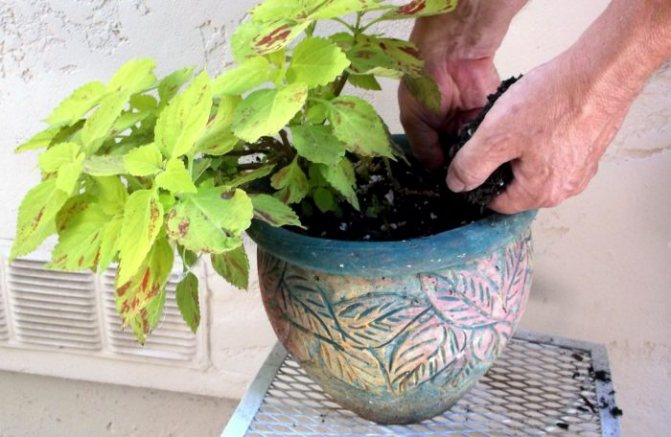

5 / 5 ( 1 vote)
Transplanting houseplants auspicious days lunar calendar technology
According to the lunar calendar 2019, it is easy to choose favorable days for transplanting domestic succulents and stem plants, making mineral and nutritious dressings, watering or cutting. The lunar calendar for transplanting indoor plantings displays all possible temporary options for carrying out various necessary procedures, as well as those days on which it is better to refrain from transplanting.
Auspicious days
Those periods are considered favorable when the moon is in the ascending phase. It is at this time that plant transplantation is the least traumatic for the roots.
On New Moon and Full Moon, Astrologers do not recommend making any rearrangements and transplants of flowering and decorative foliage pets, because plants change their life cycles. During these periods, the flows of energy and biological processes of living organisms are replaced by opposite ones. The plant is under stress, so you should not aggravate the condition of the flower with a transplant. During the New Moon and Full Moon periods, indoor flowers are not transplanted or cut off.
The exception is fertilizer, it is permissible to introduce useful substances during the Full Moon.
Transfer
Astrologers recommend checking the Lunar Schedule (calendar) when transplanting indoor flowers. The lunar phase affects the growth rate of the root system, and hence the recovery of the plant after transplantation. The period of the waxing moon is considered the most favorable for plant transplantation. At this time of the Lunar cycle, all juices are transferred to the upper part of the plant, which significantly accelerates the rate of its recovery after transplantation.
How to best transplant: technology and advice
To begin with, it is important to determine the need for a transplant. A green pet transplant is necessary if:
- You want your ward to significantly strengthen his development in growth
- He felt cramped and uncomfortable in his home (pot or other container)
- Despite the introduction of additional substances into the soil, the growth of the flower stopped
If a transplant is still necessary, then a number of simple rules should be followed:
- The first step is to prepare the pot. A used pot is poured over with boiling water or soaked in water in the evening. A new container for a houseplant should be larger than the previous one, but no more than 4 cm in diameter.
- The drainage hole is closed with special granules, stones or shards
- The plant is removed from the pot by turning it over and knocking lightly on the walls.
- Decayed and dried roots are removed. Healthy roots are white
- A small amount of earth is poured onto the bottom of the pot and slightly compacted. Then a plant with an earthen lump is placed on top and such an important soil is added along the diameter of the container, then compacted again.
- At the final stage of transplanting, the plant must be watered as generously as possible and put in a shaded, cozy place for a week. After a week, your green pet can be assigned to a permanent place of residence.
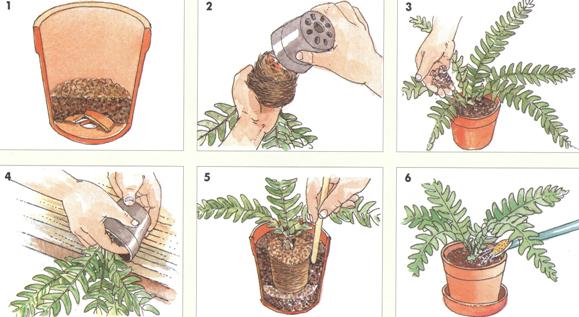

Transplanting indoor flowers in autumn September October
Autumn is the time when most plants are preparing for the winter sleep period, so it is believed that this is the time when it is best to take care of transplanting into larger pots.
Transplantation and transshipment in autumn is especially relevant for plants that sleep in winter.
In the fall, it is best to do not transplant, but transshipment, in order to minimize the impact on the root base of the plant.
The transshipment practically does not affect the roots of the flower, so this method minimizes stress. However, in the fall, you should be more careful with watering: moisture is poorly absorbed by the flower and the roots of the plant can easily rot.
The most successful days.
The result of transplanting a houseplant directly depends on the choice of the day on which the procedure is performed. The time of the year is important, and the phase of the moon according to the lunar schedule (calendar), and the constellation in which the Earth's satellite is located at a given calendar moment. Therefore, before preparing for the relocation of green potted residents, the most sophisticated growers are advised to look at the lunar transplant schedule of window sill inhabitants.
What days are favorable for transplanting indoor plants
The lunar calendar contains dates suitable for the safe transplantation of indoor plants. Usually these are the days when the juices are in the upper part of the flower - in the leaves and stems. This time is favorable for transplanting, since the roots recover faster and are less susceptible to damage. Juices move upward during the waxing moon. When the moon is waning, the roots are in the growing period and it is not recommended to disturb them.
- In January, favorable days for transplanting indoor plants: from 1-5 and from 22-31.
- In February, replanting plants is recommended from 1-3 and from 20-28.
- In March, the days of March 8, 9, 17 and 18 are auspicious.
- In April, you can make a transfer on the 24th and 25th.
- May 4,5,21,22 and 31 are favorable days.
- In June, the transplant will be most successful at 5,6,7,8,13 and 14 days.
- In July, houseplants can be transplanted on the 25th and 26th.
- August 21st and 22nd are auspicious.
- In September, flower transplants will be successful on 18, 19 and 27.
- In October, plants can be transplanted 3,4,12,13 and 14.
- November 4 and 5 are suitable days for a transfer.
- In December, it is better to refrain from transplanting domestic plants.
What is drainage and what is it for?
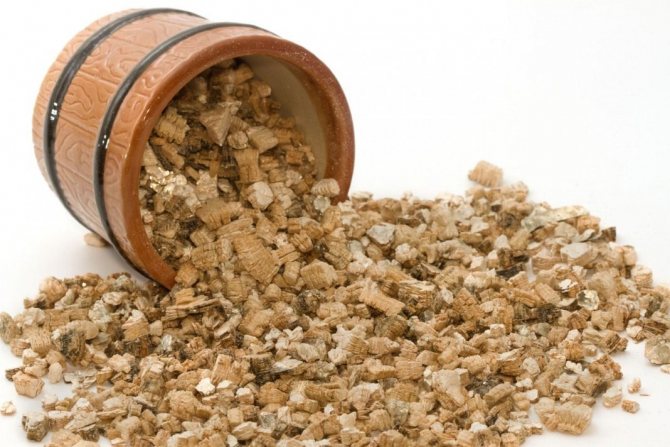

Drainage is an inert material that is placed on the bottom of the pot when planting. It is necessary to drain excess water from the earthen coma and plant roots when watering. As drainage, they mainly use small pebbles, clay shards, pieces of broken brick, coarse sand, expanded clay of various fractions, crushed foam, and in some cases sphagnum moss.
Flower transplant according to the lunar calendar
When choosing a favorable date for transplanting domestic plants, you should rely on the lunar calendar, taking into account the phase of the moon and the sign of the zodiac in which the star is located in a given time period.
Unfavorable period
Unfavorable periods for transplanting domestic plants according to the lunar calendar are the days of the new moon and full moon, as well as solar and lunar eclipses. During these periods, it is not recommended to perform a transplant or any other manipulations with indoor flowers.
Poorly suited for transplanting flowers and the waning moon. In this position of the moon, the roots of the plant are saturated with juices and are easily prone to injury.
Transplant of decorative deciduous plants
Ornamental deciduous types of indoor plants Astrologers and experienced flower growers recommend planting and planting with the rising moon. During this time period, the sensitive root system of the flower is the least susceptible to damage. Plants planted during the growth of the moon will have lush leaves and a strong stem.
The most favorable for decorative deciduous varieties is the rising Moon, located in Pisces, abiding in Scorpio, Gemini, Libra, or decreasing in Cancer.
Transplant of ampelous indoor species
Ampel and climbing house plants are transplanted with the growing moon in the zodiacal constellation Gemini, or with the waning moon in Virgo or Sagittarius.
Transplantation of bulbous and tuberous plants
Bulbous and tuberous types of domestic plants are transplanted with the growing moon in the constellation Capricorn, or waning in Scorpio.
Soil selection
Each potted crop may require a different soil composition, so the soil for planting flowers should be selected depending on the plant being transplanted. In flower shops, either specialized soils are sold (for ficuses, palms, violets, cacti, begonias, etc.), or universal (for decorative leafy, decorative flowering, cacti and succulents, etc.).
Knowing the peculiarities of growth and soil preferences of the flower, you can not only choose the right ready-made soil, but also improve the quality of the universal one - add various rippers (peat, coconut, perlite, vermiculite) and vermiculite to the composition.
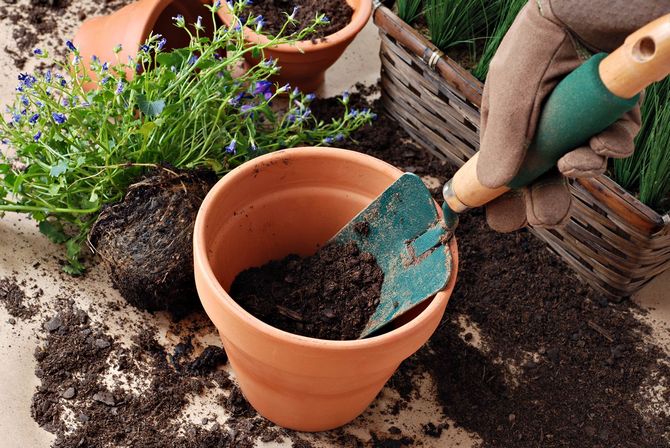

Potted flower transplant when and how is it better
The successful or unsuccessful outcome of a plant transplant depends on the phase of the moon, the sign of the zodiac in which the moon is located and on the observance of the transplant rules.
When to transplant indoor flowers
The growing Moon in the constellations Taurus, Scorpio, Cancer or Pisces is most favorable for transplanting indoor flowers.
It is important to take into account the individual characteristics of the plant and recommendations for transplanting specifically for this species.
Recommendations
It is recommended to consider 3 main points for a successful plant transplant:
- The flower really needs a transplant
- All preparatory measures for transplanting were taken, taking into account the individual characteristics of the plant: the correct size of the pot, soil, drainage was selected
- The phases of the moon and the sign of the moon at the time of transplantation are taken into account
When it is better not to transplant
It is not recommended to transplant flowers on New Moon, Full Moon and a few days before and after. It is highly undesirable to plan a transplant on days of solar and lunar eclipses. Plants are not transplanted at the time of budding, flowering or disease.
General transplant rules
- You should not take a pot of much larger volume for transplanting than the existing one.
- Before transplanting, the pot must be thoroughly washed
- The plant is thoroughly watered before transplanting to facilitate the process.
- Plants cannot be transplanted during flowering and a set of buds.
Post-transplant care
After transplanting, the plant is watered abundantly and put in the shade for a week. During this period, the root system adapts to new conditions and recovers, the plant is under stress, therefore bright light and fertilizers are contraindicated for it.After a week, the flower can be assigned to a permanent place.
How to plant a flower correctly?
Experts identify three ways to transplant indoor plants:
- complete transplant;
- transshipment of a flower with an earthen clod into a larger pot;
- partial soil replacement.
In the latter case, the topsoil is loosened to a depth of 5-7 cm and poured out of the pot. When loosening, try not to hurt the roots. The free space is filled with new soil and lightly tamped. After the procedure, the flower is watered.
The first two methods are similar to each other and are performed in the same sequence.
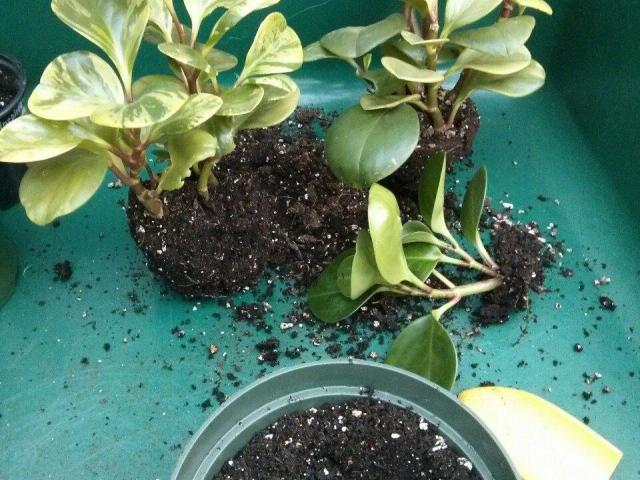

Features and rules
The frequency of a planned transplant depends on the age of the flower. Young specimens need an annual procedure, plants whose age is from 3 years - every 3-4 years. For long-livers grown in tubs, it is enough to change the top soil layer 1-2 times a year.
Before transplanting, new soil and a pot should be purchased. The soil is bought in a store or prepared independently according to the requirements of the cultivation of this species.
The pot must meet the basic requirements:
- diameter and depth - 2-3 cm larger than the old one;
- have a sufficient number of drainage holes to drain excess moisture;
- the material must protect the roots from hypothermia and overheating.
Expanded clay, pebbles or broken bricks are used as drainage. They are pre-disinfected in boiling water or in an oven.
Additionally, you may need a knife, shovel, garden shears. The knife and scissors are disinfected. Charcoal, ash or other antiseptic is also prepared.
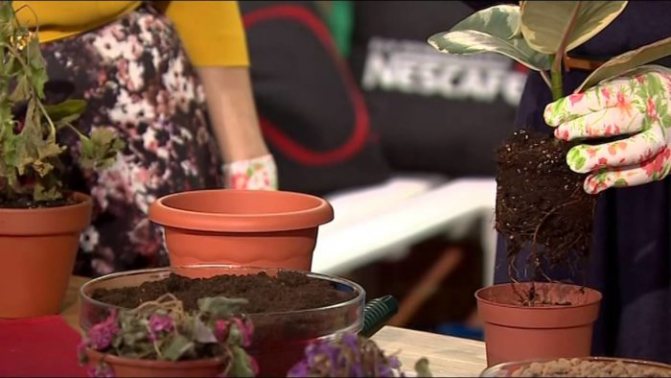

Step-by-step instruction
The necessary materials and tools are stacked in one place so that, if necessary, they are at hand. Next, work is performed in the following sequence:
- The new pot is washed and placed in water for 30-40 minutes so that it is saturated with moisture. If an old flowerpot is used, it is cleaned of salts, washed and poured over with boiling water.
- The flower pot is immersed in water for 20-30 minutes.
- Drainage is poured into a new pot with a layer of 2-3 cm, covering the holes with it.
- A small layer of fresh soil is poured on top of the drainage, building a mound in the center.
- The plant, together with the earth lump, is taken out of the pot. To do this, the flower is turned upside down and held in place. The pot is gently pulled upward, releasing the roots from the soil. If they are difficult to remove, then use a spatula, inserting it between the walls and the ground.
- When transferring, the roots with the earth are lowered in the center of the pot. The free space between the walls and the lump is filled with new soil, periodically tamping it slightly with your fingers.
- With a full transplant, the roots are shaken and freed from the ground. The roots are carefully examined. Dry, rotten and broken are cut to healthy tissue with a knife or pruning shears. The cut sites are sprinkled with charcoal or treated with an antiseptic.
- The plant is lowered into a pot in the center, so that the root rosette is 1.5-2 cm below the edge. The roots are evenly distributed over the entire surface. The free space is filled with fresh soil, lightly tamped. Ground is poured to the level of the root rosette.
- The transplanted flower is watered, a dry soil mixture is poured on top, the pot is placed in the shade for 5-7 days.
Output
Our ancestors have long lived in harmony with nature and its cycles: seasons, phases of the moon. It is not for nothing that many folk signs are closely intertwined with these factors, because all processes in nature are interconnected. The lunar calendar can be an excellent help for every gardener and florist, both experienced and novice.


Elena Zavyalova
I have been living according to the lunar calendar since 2012. I first tested all the practices that I am talking about on myself.
Possible mistakes
1. Unsuitable soil in terms of composition and acidity.
2. The size of the pot does not correspond to the volume of the root system.
3. Planting / transplanting a plant at the wrong time for him.
As you can see, planting a houseplant in a new pot is pretty easy! You just need to know the main points of the correct choice of soil, capacity for planting, technology and choose the right time for transplanting.
Growing flowers at home is not the most difficult task. However, some plants always feel great, while others have to throw another green pet that died after an unsuccessful transplant into the trash bin. So that after this procedure the plants do not die and bloom, it is necessary to follow the technology, take into account the peculiarities of soils, pots and avoid common mistakes.
You can plant not only indoor plants in pots, but also outdoor plants. In the latter case, containers are installed on loggias, balconies, terraces, summer cottages and flower beds. Roses, tuberous begonias, petunias and viola grow well in pots. These colors require not only a lot of light, but also fresh air, which is usually not enough in the apartment.
If you plan to grow a plant in the house, then you need to pay attention to which side the windows face. In the north, unpretentious species such as cacti and succulents are grown. It is better to use the southern window only in winter, placing pots with thermophilic and light-loving subtropical plants on it. It's too hot on this side in summer for any flowers other than cacti.
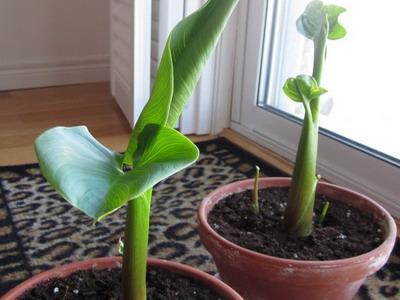

The best options for potted plants are west and east windows.
Potted flowers can be planted at any time of the year. The best time to divide and transplant most plants is in early spring.
A novice florist who decides to transplant his plants does not have to make his own soil mixture. Soil preparation is a rather difficult task that can only be solved by experienced specialists.
In the retail network, you can now find ready-made soil mixtures for almost any indoor and outdoor plants. They are inexpensive and are quite suitable for the amateur growing of home flowers. The most unpretentious ones can be planted even in universal and seedling soils.
Store mixes are usually already disinfected. They do not need to be watered with potassium permanganate, heated or otherwise freed from parasites and sources of infection: bacteria and spores of microscopic fungi. Also, you do not need to add fertilizers to them.
The trade network contains many pots and pots for indoor and outdoor plants. If you do not take into account the exclusive vessels made of materials atypical for growing (metal, wood, stone), then you have to choose between plastic and ceramics.
Plastic pots are inexpensive and lightweight. Growing indoor krupnomers - dracaena, ficus, zamioculcas, dieffenbachia - have to reckon with their size and weight. Therefore, for large indoor plants, it is better to purchase light plastic containers that can be moved around while caring for green pets. Sturdy pots made from this material are indispensable for creating vertical compositions.
Such vessels are not used when growing very tall plants, as they can tip over in a light container. An important disadvantage of plastic is that the material does not breathe, and the lack of air has a bad effect on the development of roots.
Moon calendar for march 2020
There is more than one auspicious day for transplanting indoor flowers. These can be days following one another, while a certain lunar phase lasts. For March 2020, the following phases of the moon can be distinguished, marked on the calendar.
So, in March, the days to which attention is paid will be distributed as follows:
- March 1 - 8, 2020 - The moon is growing;
- March 9 - full moon;
- March 10 - 23, 2020 - Waning Moon;
- March 24 - new moon;
- March 25 - 31 - Waxing Moon.
The most favorable days are March 1, 4, 5, 6, 27, 28. The moon is in the following signs:
- March 1, 27, 28 - in the sign of Taurus;
- 4, 5 and 6 - in the constellation Cancer.
These days are good for any kind of work.
Attention! It should be borne in mind that the lunar day lasts 24.5 hours, and their number in the month is 29 - 30, which is different from a simple calendar. If, when determining the day of work, there is a discrepancy between the phase of the moon and the sign of the horoscope, they are guided by the sign.


Lunar calendar for March 2020
Using such a calendar allows you to protect yourself from mistakes when working with domestic plants, those associated with sowing, planting and replanting. The tables indicate what is permissible to do with agricultural technology. The full correspondence of the lunar phases and zodiacal signs is calculated for each day and month of the season individually.
Basic rules for transplanting flowers into another pot
For a successful transplant of a flower into a new pot, it is recommended to perform the following simple steps:
- Water abundantly 3 days before transplanting.
- Select and prepare a pot by rinsing and drying, disinfecting if necessary.
- Pour drainage on a third of the height of the planter.
- Place a small amount of soil on the drainage, tamp it.
- Carefully remove the flower together with the earthen lump from the pot.
- Trim rotten roots and treat them with charcoal.
- Place the flower in a new pot at the same depth as in the old one.
- Fill the remaining space with new soil.
- Resume watering after a few days.
- Feed the plant in a month and a half.
Subject to these rules, plant transplantation will work even for a novice gardener.
By replanting plants, you provide them with the necessary care, prolong their life, and contribute to their healthy growth. And they, in turn, delight you with their beauty.
Big plant
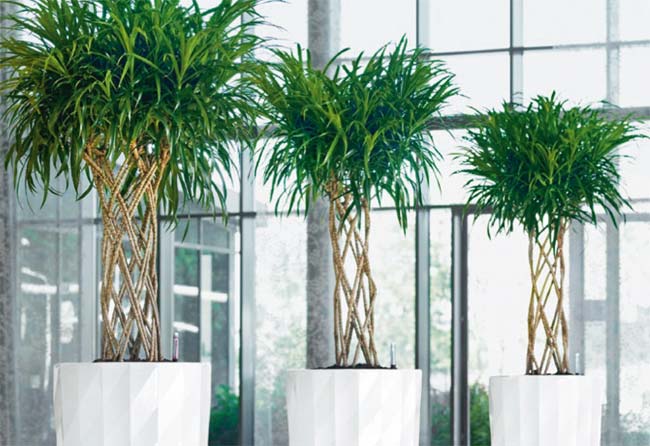

When a home flower grows to an impressive size, transplanting it becomes almost impossible. Ficuses, hibiscus, and some other varieties often reach similar sizes. If you try to transplant such a colossus at home, you can severely damage the flower, break it, or cause other injuries or injuries to it.
But, although it is impossible to transplant a large flower, you need to periodically add fresh soil to its pot. If this is not done, the soil will gradually be completely depleted, and the plant will wither and die. Of course, it is not possible to completely replace the substrate with a fresh one in this case: the growers simply add the nutrient substrate to the side of the plant. It is necessary to add fresh soil with a layer of at least 4 cm: a smaller volume practically does not make sense.
Sometimes they remove the top layer of the earth and replace it with another, new one. This procedure must be carried out very carefully so as not to remove part of the roots along with the top layer. It is recommended to carry out the procedure either once a year, or twice: in spring and autumn.
What flowers can not be planted at home
When choosing flowers for home growing, it is worth approaching this issue from a scientific point of view. Some of the flora can be poisonous, allergenic, and emit a suffocating aroma.
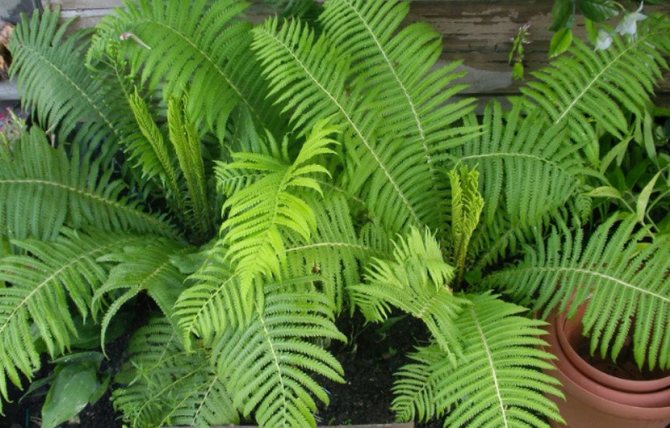

All types of Euphorbia are poisonous. When the stems or leaves are cracked, they secrete a white "milk", which, when it comes into contact with open areas of the skin, causes an allergic reaction, accompanied by hyperemia, itching, and tingling.
You should also be careful with cacti, which have many sharp thorns - they need to be kept out of the reach of children.
Allergen plants include:
- ferns;
- cyclamens;
- rhododendrons;
- geraniums;
- pelargonium.
Forcing on time
And the terms for all people are different - someone needs a basket of snowdrops for the New Year, and someone needs a bouquet of hyacinths by March 8. Forcing time depends on the type of plant and the specific variety, but on average it is 3-4 months. It is on the basis of this fact that the time for landing is calculated. It usually falls in the autumn period, when the bulbs or rhizomes are planted in a fresh substrate and left at above-zero temperatures in the cellar or on the lower shelf of the refrigerator,and after root formation and the start of shoot growth, they are brought into the light in conditions suitable for flowering. Each culture, of course, has its own requirements and characteristics.


Blooming hyacinths
Find the right pot
Pots vary in size, material and drainage hole.
The size
The roots of the plant should fit freely in the pot, while there should be another two to five centimeters from all sides to the walls. In a pot that is too tight, the flower will not grow and will constantly dry out, and in a pot that is too large, water will stagnate and the flower can rot. A few centimeters should also remain from the soil to the top edge of the pot so that the water does not overflow.
In some plants, the roots stretch down several meters. In this case, you need to look at the bulk of the roots. Roots that are too long can be placed on the bottom in rings or pruned.
Material
The materials from which the pots are made can be divided into water-permeable and waterproof. So, on the wall of a clay (terracotta) pot, after watering, wet spots appear, and after a few months a white bloom from salts may appear. Such a pot breathes with its entire surface, evaporates water from the walls. It is suitable for plants whose soil should not be constantly wet: cacti, ficuses, monstera, epipremnum, philodendrons, sansevieria, and some orchids.
Waterproof materials are plastic and ceramics. Such a pot evaporates water only from above, the soil in it remains moist longer. It is easier to grow calatheas, ferns, begonias, flowering plants in these pots. It is better not to use glass pots - the earth inside does not look aesthetically pleasing at all, algae and even fungi appear on the walls very quickly.
If you are an experienced grower, you can plant the composition in a glass florarium - a complex geometric shape with an open or closed top. This landing has many nuances, so I would advise beginners to look for special master classes.
Drainage holes
A pot without a hole in the bottom is a planter. In the West, inside the planter, they hide a plastic pot in which the plant is sold. Plants are not transplanted, they are bought for several years - like a long-lasting bouquet. Many of us plant plants directly in pots. Such a plant cannot be watered abundantly - there is nowhere to go for extra water. If you want to take the flower to the shower, you will have to close the ground with a bag. Growing in pots requires experience and intuition.
For very moisture-loving plants, self-watering pots are sold (other names are smart watering, wick watering). In such a pot there is a separate reservoir of water, due to which the plant is constantly moistened. Self-watering pots are more expensive than usual (starting from 600 rubles), but they will help the plant survive seven to ten days of your vacation. The autowatering system can be assembled by yourself.
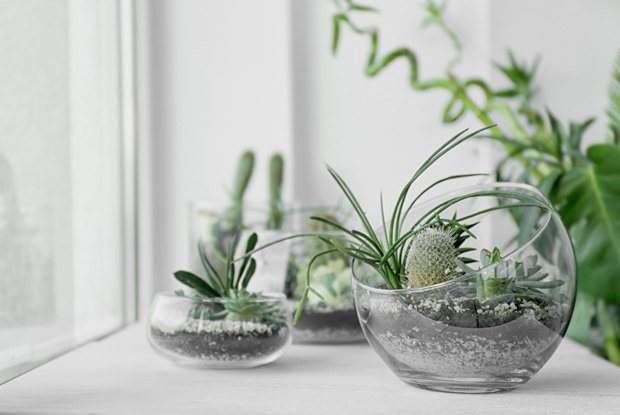

Transfer after purchase
It is not always necessary to transplant a flower after buying it in a store, but in most cases it is desirable. In the store, flowers are sold in small pots that stimulate early flowering of plants. This, of course, is good for sale, but leads to problems with long-term cultivation. There is little space in such a pot, food and water, therefore, too: there is nowhere for the flower to grow and develop.
Do not transplant immediately after purchase: you must first give the flower time to adapt, get used to the new home. After a week or two, carry out the procedure.
The influence of stars on plants
Almost all house flowers correspond to one of the zodiac signs. In order for indoor plants to harmoniously influence the atmosphere of your home, it is worth considering these features and choosing exactly those flowers that are most suitable for you. (see children born in the year of the Pig 2019)
- To those who were born under the sign Aries
plants that are affected by the planet Mars are great. These include monstera, delicosis, scindapsus, aucuba, philodendron, fatsia.Such flowers have a tart or bitter taste, a specific, strong odor, thorns or thorns.
- Zodiac sign calf
is under the auspices of Venus and the flowers that correspond to it have a delicate aroma, graceful and refined. These can be: fuchsia, hydrangea, indoor pomegranate, oleander, papyrus, succulents, fatsia, poppies. - On the sign Twins
the planet Mercury affects: staples, phloxes, cacti, pansies, violets. Mint, aloe and other medicinal herbs can be grown. - The moon affects the zodiac sign Cancer
... Such people should pay attention to different types of palm trees, azalea, mint, croton, lemon tree, begonia, ficus, chefler. These flowers have large leaves and a root system. - On the Lviv
especially the Sun affects, flowers should serve as a decoration of the room: hibiscus, cadenium, balsam, echeveria, chlorophytum, cyclamen. - Virgins
, like Gemini, is ruled by the planet Mercury. If you plant tradescantia, chamedorea, indoor jasmine or hippeastrum at home, present them as a gift to your friends who were born under these signs of the zodiac. - On the sign Scorpion
is influenced by distant Pluto. The flowers of this sign are exquisite, have beauty and mystery. These are: pomegranate, begonia, gusmania, azalea, spurge. - Patron saint Streltsov
is the planet Jupiter, one of the largest and most energetically strong. The flowers of this constellation should carry the same qualities: ficus, hydrangea and lemon. - Aquarius
from
Capricorn
unite under the strong influence of Saturn. This planet includes: gasteria, hamedorea, dieffenbachia, allocasia, and indoor fern. - For people born under the constellation Pisces
, geranium, kufea, mimosa, indoor ivy, stephanotis, adenium, dracaena and any flowers that have a positive effect on the nervous system are best suited.
You can plant indoor plants that do not match your zodiac sign, but in this case, it is better to choose flowers that belong to neighboring signs.
Lunar health calendar for 2019
How to prevent yourself from melancholy, seasonal illnesses and ill health? It is worth getting a little closer to nature and living in accordance with the phases of the moon.
Let the plant recover
Caring for a flower after transplanting depends on its characteristics. Dry-loving plants (dracaena, yucca, cacti, succulents) should not be watered immediately. You need to wait a few days for the wounds to heal on the roots, and only then can the soil be moistened. Unpretentious tropical plants can be watered immediately, and at the same time add land, which inevitably settles.
Newly purchased plants should be protected from the scorching midday sun: put them behind tulle or in front of a mosquito net, attach a sheet of white paper to the glass. It is not scary if, after transplantation, several lower leaves turn yellow and fall off. The plant redistributes resources: it takes nutrients from the leaves and directs them to the growth of new roots. For the same reason, the flower does not grow for some time after transplantation - it is just that all processes take place underground, it grows roots.
If the flower sheds its leaves, you can spray it with adaptogen preparations that will help to cope with stress: Epin, HB-101. Fertilizers are best applied after a few weeks. I do not fertilize: there are enough nutrients from fresh soil for unhurried growth.
Who will help with the transplant
Studio Plant Me Moscow
Plants for Friends
Botanic Moscow
It is difficult for me to remember that after a transplant someone got sick or died. If this happens, then either the plant was very moody, or it got sick while still in the store. When a plant is comfortable with light, temperature, humidity and watering, it is likely to respond well to replanting. Again, if the flower grows quickly or you want to change the pot for it, it is quite possible to cross it several times per season.
Photos: cover, 3 - Africa Studio - stock.adobe.com, 1, 5 - Plants for Friends, 2 - PhenomenalPhoto - stock.adobe.com, 4 - vnlit - stock.adobe.com,
When is it better to replant plants
Phytosporin for indoor plants: instructions for use
In which month to replant flowers: June, February? If we talk about the best moment for a transplant, then you should choose the time from the end of February to April inclusive. The awakening of the plant, the growth of new shoots and leaves contribute to this event and ensure a normal vegetation throughout the season.
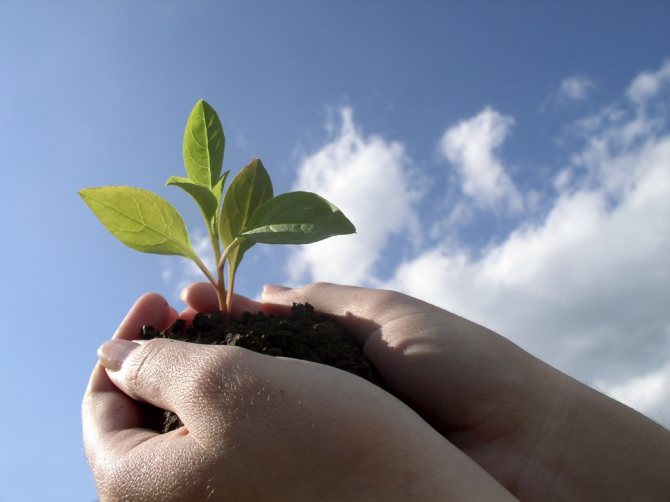

Sprout awakening
Transplanting indoor flowers in autumn
The beginning of autumn is always associated with a decrease in ambient temperature. September and October are unwanted months for a transplant. It should be performed only as a last resort. Plants prepare for winter, and their vital processes are markedly reduced. However, if you have to do this, you need to check with the lunar schedule.
Helpful Tips for Beginners
Beginners in floriculture are often unlucky with the cultivation of their favorite flowers, therefore, when planting and further caring for a plant, it is worth listening to the opinion of experienced florists.
The main recommendations in this case will be as follows:
- selection of the optimal size of the pot (it may be larger than the previous one by only a few centimeters);
- choosing the most suitable period for planting seedlings (usually it should be in March);
- the need for careful handling of the root system, but with the obligatory removal of dried and dead roots;
- the use of a drainage layer for all types of indoor flowers;
- the use of only special soil, the composition of which will fully meet the needs of each individual species;
- the absence of voids under the earthen clod of the plant and around it;
- free space above the ground: the ground level should not reach the very edge of the pot, so that when watering, water does not flow onto the windowsill.
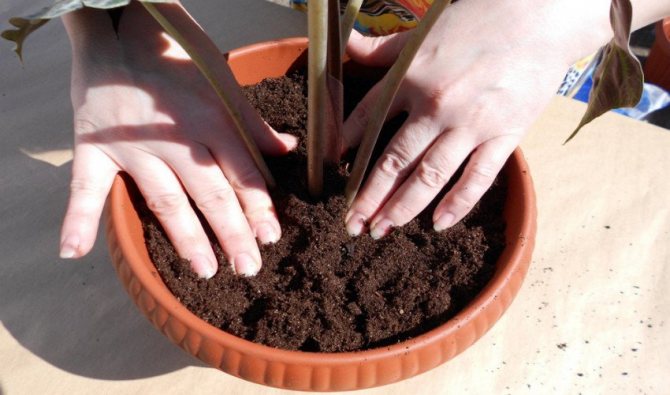

After planting the flowers, they should be well watered so that the soil subsides a little (this requirement does not apply to dry-loving varieties), and then you can place the pot in the most suitable place for it.
In general, the process of planting indoor vegetation will take no more than an hour, but only if you prepare everything you need in advance. And as a reward for the efforts, the florist will receive an excellent decorative element, which, moreover, can have a positive effect on the general emotional state of the household.
Select or prepare soil
What the roots of a plant are in is usually called a soil or substrate. This is not always the land we are used to: plants can be grown in coconut fiber, pine bark, moss, fired clay, stones, synthetic materials or in an aqueous solution with electrolytes.
For most plants, universal peat-based substrates are suitable, the word "universal" will be right in the name. Unfortunately, the composition on the packaging does not distinguish between good and bad soil. Bad soil is light, red in color, water on it collects in balls, does not go inside for a long time, gurgles on the surface. Over time, such soil compresses into a lump, lags far behind the edges of the pot, deep grooves form around the perimeter. Water rapidly flows past the ground into the sump, the soil is not wetted, the plant dries up. A good soil is black-brown, quickly and evenly soaked with water, when it dries out, it changes slightly in volume.
The earth can be gently tamped with your fingers to push it between the roots, fix the plant vertically. Leaving air pockets does not make sense: the earth will settle after the first watering. To help the earth settle evenly, you can gently tap the pot on a horizontal surface or tap the side of the pot with your palm.
I like the following brands:
"Compo Sana universal"
"Geolia universal"
"Fasco floral"
Other tested soils can be found from friends, flower growers or in a group of indoor plant lovers.
For some plants, you will have to search or even prepare a special mixture. For phalaenopsis (the most popular orchids), you need to buy pine bark and cut into large cubes. Cacti and other succulents are planted in a mixture containing at least half of the baking powder: stones, coarse sand, lava chips, zeolite. For the Venus flytrap (insectivorous plant), you need to buy pure high-moor peat. The more rare or capricious the plant, the more work you have to do.


Major mistakes
The flower is transplanted immediately into an oversized pot. After the procedure, the plant is often watered or fertilized. This makes it difficult to adapt, since under stress the roots slowly absorb moisture and minerals.
The rate of subsequent recovery depends on which moon the transplant was carried out. Therefore, the execution of the procedure in a decreasing phase is also considered an error.


Sunburn on the leaves is possible even from the usual lighting regime, therefore it is recommended to remove the flower in partial shade after transplantation.
When a transplant is needed
We will find out what moments indicate that it is time to transplant a home plant.
After purchasing
Having bought another plant, it is necessary to transplant it after a certain time. In the store, the flower is sold in a small pot, designed for a temporary stay. At home, you need to choose a container that is more suitable for him.
But you should not carry out a transplant right away. First, give the flower time to adapt - this period can take from one to a couple of weeks.
If the flower has outgrown the old container
When the plant does not fit in the old container, it is time to replant it. This procedure is usually carried out as planned. In the old pot, the roots have already completely mastered the earthen lump, sucking out all the juices and nutrients from it. There is no possibility to develop further in the old "house". Often at the same time, the roots look out of the drainage holes at the bottom.
You should know that in crowded conditions, plants are more susceptible to attacks by pests and various diseases. Development, however, may stop altogether due to the lack of nutrients.
Usually, young animals that are not yet three years old are transplanted annually, while specimens of a more respectable age are transplanted every 2-3 years. If the soil in the pot is renewed in time, the plant constantly receives nutrition - a sufficient amount of trace elements and minerals. Thus, the flower always looks well-groomed, healthy and lush. Lack of nutrition immediately affects the appearance of the plant, and a little later on health.
If the flower is sick or waterlogged
If the flower begins to fall ill: it turns yellow, leaves fall off, the soil in the pot turns sour, signs of root rotting appear, a transplant is urgently needed. In this case, the procedure is carried out unscheduled. Delay in the decay of the root system is unacceptable: the plant, if not transplanted, may die.
Advice
Often it is impossible to transplant - many indoor plants do not like the procedure and it is difficult to recover after it. Often transplanting without important reasons, you can reduce the immunity of the flower, and sometimes destroy it.
Features of the transplant process
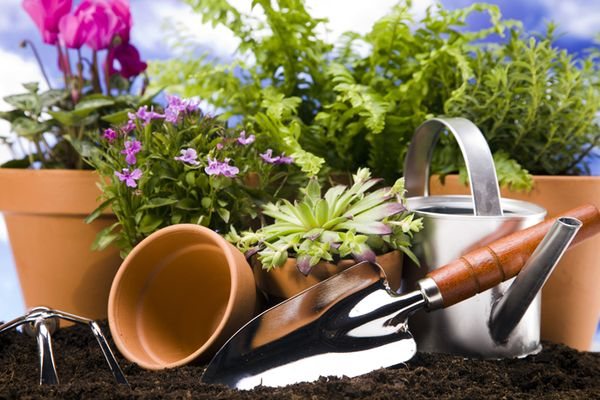

We will consider in detail and step by step the process of transplanting indoor flowers, we will understand all the intricacies of this procedure.
What tools will be needed
- The first and most important thing for a successful transplant is a suitable soil and a correctly selected pot. In addition, you will need a pruner to cut off rotten, overgrown roots, shoots and leaves.
- A scoop is also needed to pour soil into a new container. If the pot is small, you can, however, use a tablespoon.
- Prepare a knife, which is needed if the roots of the plant grow into the walls of the pot: in this case, you will need to separate them.
- To tamp the substrate, arm yourself with a stick or pencil if the pot is small.
- Of materials, in addition to soil, drainage will also be required: expanded clay, pebbles, broken brick, other materials can also be used.
Process
- Water generously on the soil in an old pot so that the plant can be pulled out more easily. Let the soil soak.
- Gently remove the plant and shake it off the ground.
- Inspect the roots: if you find rotten, dried out roots, remove them immediately. After trimming, treat the damaged areas with potassium permanganate or sprinkle with charcoal.
- Place drainage on the bottom of the new pot, then soil up to a third or half the height of the pot.
- Place the plant in the center of a new container, stand upright, sprinkle with soil on all sides. At the same time, you must hold the flower with one hand.
- If the roots have joined together, spread them out: otherwise, the flower may not take root.
- Fill the soil to the top: so that the root collar of the plant is flush with the soil surface.
- Tamp the soil. After tamping, the earth should not reach the edges of the pot by one and a half to two centimeters. Otherwise, there may be problems with watering.
- Water and place the flower in a secluded place, do not disturb it for a while - give it an opportunity to get used to it, adapt.
Advice
After transplanting, many indoor plants need especially abundant and frequent watering: water helps them better adapt, take root in a new place. The exception is succulents: it is advisable not to water them at all for three days after the procedure, so that easily injured delicate roots can recover.
How to make a transplant correctly
- Houseplants are only transplanted when they need it. When we are not sure if the plant needs replanting, we must pull it gently out of the pot.
- Turn the pot upside down and press on the edge of the table to gently remove the plant.
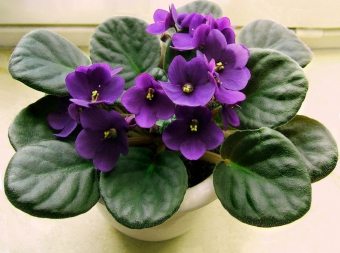

- If the roots have completely outgrown the ground and formed a compact body, it's time to give them a new pot.
- Before you start replacing the soil, make sure that the plant is in good shape, there are no signs of disease or pests. Repotting can weaken the plant.
- Don't let the roots come out through the hole in the bottom of the pot. If, however, they have already done so, you must remove or pull them out. After covering the plant with new soil, gently shake the pot so that the soil fills all the places. In the end, you need to water everything.

